HFF 2015 Interview: Bob Burnett, Director of The Art of Richard Thompson
By heartlandfilm on September 24, 2015http://heartlandfilm.org/hff-2015-interview-bob-burnett-director-of-the-art-of-richard-thompson/
 | Blog posts by Richard ThompsonIllustration work for Electrical Contractor and Contingencies Published on March 06, 2023 Billions of billions of drawings - Richard draws Carl Sagan Published on March 07, 2023 How to strengthen your real estate market illustration, and a TCDS piece Published on March 08, 2023 Chatfield on Thompson by way of Searle Published on March 08, 2023 This year's Team Cul de Sac donation link Published on March 09, 2023 0 Richard Thompson, Chameleon Published on March 09, 2023 Richard lifting his mother's Suitcases (updated) Published on March 10, 2023 |
 by Mike Rhode
by Mike Rhode 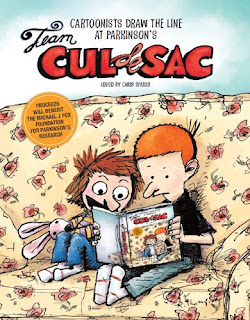 CS: Mainly it's using blank coasters where they can sketch or 5x7" pieces of paper that they can draw on. We have it set up that it's between $5 and $50 for these little drawings. From there, we ask donations of larger pieces so we can auction them off for $200, 300, 500 at the larger Heroes Con art auction the following night. We've also had some live-painting events at a the D&D too.
CS: Mainly it's using blank coasters where they can sketch or 5x7" pieces of paper that they can draw on. We have it set up that it's between $5 and $50 for these little drawings. From there, we ask donations of larger pieces so we can auction them off for $200, 300, 500 at the larger Heroes Con art auction the following night. We've also had some live-painting events at a the D&D too. |
Seth Peagler, who helps set up the Drink and Draw, Shelton Drum & Chris Sparks
|
 |
| Shelton Drum, Tony Harris, and Mr. Harris' son |
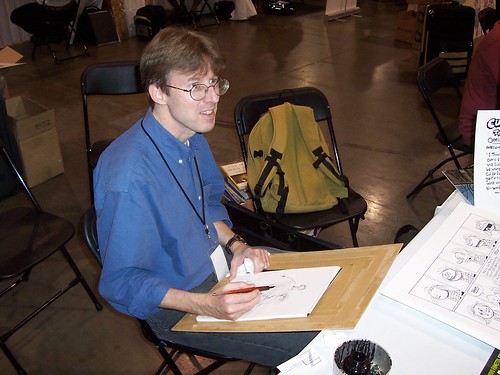
"Calvin and Hobbes" creator Bill Watterson has said about Richard Thompson's "Cul de Sac": "The strip has a unique and honest voice, a seemingly intuitive feel for what comics do best ... a very funny intelligence." Thompson, who also draws The Washington Post's "Richard's Poor Almanac," discusses the world of comic strips and highlights some of his favorites. This event is presented in collaboration with McDaniel College and the exhibition Kings of the Pages: Comic Strips and Culture 1895-1950, on view at McDaniel through November 19.


Named the Outstanding Cartoonist of 2010 by the National Cartoonists Society, Richard Thompson is best known for his syndicated series, Cul de Sac. But his work encompasses much more, and in this colorful career retrospective, six of his peers present the different facets of Thompson's art. Join Galifianakis, Washington Post cartoonist and author of If You Loved Me, You'd Think This Was Cute, Weingarten, Pulitzer-winning journalist who writes The Washington Post's "Below the Beltway" column, and Apatoff, an illustration scholar whose recent work includes a biography of illustrator Robert Fawcett. They will be interviewed by Michael Cavna, writer, artist, and lapsed cartoonist now producing The Washington Post's "Comic Riffs." (Andrews McMeel)
 We also got to see Art Harrison performing on his homemade Theremin in the little veterans park up the block.
We also got to see Art Harrison performing on his homemade Theremin in the little veterans park up the block.
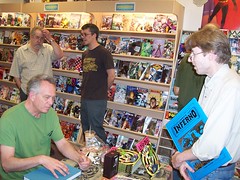
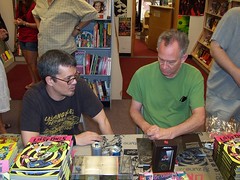
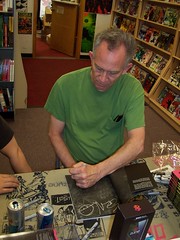
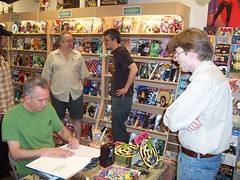


 Not a hoax. Not a joke. Not an April Fool's day trick. Here's an excerpt of the conversation of Richard Thompson and Bill Watterson from The Art of Richard Thompson, which you can buy right now from Amazon or Barnes & Noble, or order and wait for a copy signed by Richard from One More Page.
Not a hoax. Not a joke. Not an April Fool's day trick. Here's an excerpt of the conversation of Richard Thompson and Bill Watterson from The Art of Richard Thompson, which you can buy right now from Amazon or Barnes & Noble, or order and wait for a copy signed by Richard from One More Page. RT: Some strange ones. There was a panel called Mr. Tweedy about a hapless little guy. I don't remember who drew it. And there was Freddy by a guy who signed as Rupe. I think he was local.
RT: Some strange ones. There was a panel called Mr. Tweedy about a hapless little guy. I don't remember who drew it. And there was Freddy by a guy who signed as Rupe. I think he was local. BW: I could never see a way in. I couldn't imagine myself drawing movie and TV satires. I guess Don Martin did the closest thing to a regular cartoon, but in that grotesque style. Or Dave Berg's whatever....
BW: I could never see a way in. I couldn't imagine myself drawing movie and TV satires. I guess Don Martin did the closest thing to a regular cartoon, but in that grotesque style. Or Dave Berg's whatever.... RT: I didn't quite understand them. There's a Roz Chast drawing about her as a child finding Charles Addams cartoons, and I remember finding those too, and how gruesome they were. And the painting in them was soft and..
RT: I didn't quite understand them. There's a Roz Chast drawing about her as a child finding Charles Addams cartoons, and I remember finding those too, and how gruesome they were. And the painting in them was soft and.. BW: One summer my neighbor gave me this huge box of Archie comic books, and I read them in the car on some family vacation. I have no idea where he got them, but there were a zillion of the things, so my brother and I sat in the back seat reading one after another until it nearly killed us. We read ten thousand Archie comic books and they were all exactly the same.
BW: One summer my neighbor gave me this huge box of Archie comic books, and I read them in the car on some family vacation. I have no idea where he got them, but there were a zillion of the things, so my brother and I sat in the back seat reading one after another until it nearly killed us. We read ten thousand Archie comic books and they were all exactly the same.